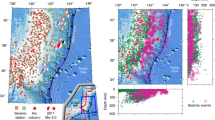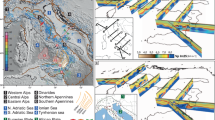Abstract
Earth holography was applied to Norwegian Seismic Array (NORSAR) earthquake P-wave recordings. Simulation of the NORSAR sensor configuration indicates that a satisfactory reconstruction of the essential features of an embedded body is feasible with a depth resolution which seems to be better than that attained using more traditional time and amplitude inversion schemes. The earth holography concept was tested using NORSAR recordings of three deep earthquakes at teleseismic distances. The results indicate lithospheric heterogeneous bodies with a significant vertical extent. The most pronounced scattering features of these inhomogeneities are located at depths around 100, 148 and 212 km.
This is a preview of subscription content, access via your institution
Access options
Subscribe to this journal
Receive 51 print issues and online access
$199.00 per year
only $3.90 per issue
Buy this article
- Purchase on Springer Link
- Instant access to full article PDF
Prices may be subject to local taxes which are calculated during checkout
Similar content being viewed by others
References
Aki, K. J. geophys. Res. 78, 1334–1346 (1973).
Berteussen, K.-A., Christoffersson, A., Husebye, E. S. & Dahle, A., Geophys. J. R. astr. Soc. 42, 403–427 (1975).
Nikolaev, A. V. The Seismics of Heterogeneous and Turbid Media (Keter, Jerusalem, 1975).
Aki, K., Christoffersson, A. & Husebye, E. S. J. geophys. Res. 82, 277–295 (1977).
Christoffersson, A. & Husebye, E. S. J. geophys. Res. 84, 6168–6176 (1979).
Gubbins, D. in Identification of Seismic Sources (eds Husebye, E. S. & Mykkeltveit, S.) (Reidel, Dordrecht, 1981).
Haddon, R. A. W. & Husebye, E. S., Geophys. J. R. astr. Soc. 55, 19–44 (1978).
Thomson, C. & Gubbins, D. Geophys. J. R. astr. Soc. (in the press).
Cleary, J. & Haddon, R. A. W. Nature 240, 549–550 (1972).
Gabor, D. Nature 161, 777 (1948).
Shewell, J. R. & Wolf, E. J. opt. Soc. Am. 58, 1596–1603 (1968).
Bungum, H., Husebye, E. S. & Ringdal, F., Geophys. J. R. astr. Soc. 25, 15–26 (1971).
Lalor, E. J. math. Phys. 9, 2001–2006 (1968).
Magninness, M. G. J. Sound Vibr. 20, 219–240 (1972).
Tsybulchik, G. M. Geol. Geophys. No. 11, 97–105; No. 12, 22–31 (in Russian) (1975).
Berkhout, A. J. Seismic Migration (Elsevier, Amsterdam, 1980).
Ramberg, H. J. geophys. Res. 77, 877–881 (1972).
Ramberg, I. B. & Neumann, E. R. (eds) Tectonics and Geophysics of Continental Rifts, 245 (ReidelDordrecht, 1978).
Author information
Authors and Affiliations
Rights and permissions
About this article
Cite this article
Troitskiy, P., Husebye, E. & Nikolaev, A. Lithospheric studies based on holographic principles. Nature 294, 618–623 (1981). https://doi.org/10.1038/294618a0
Received:
Accepted:
Issue Date:
DOI: https://doi.org/10.1038/294618a0
Comments
By submitting a comment you agree to abide by our Terms and Community Guidelines. If you find something abusive or that does not comply with our terms or guidelines please flag it as inappropriate.



